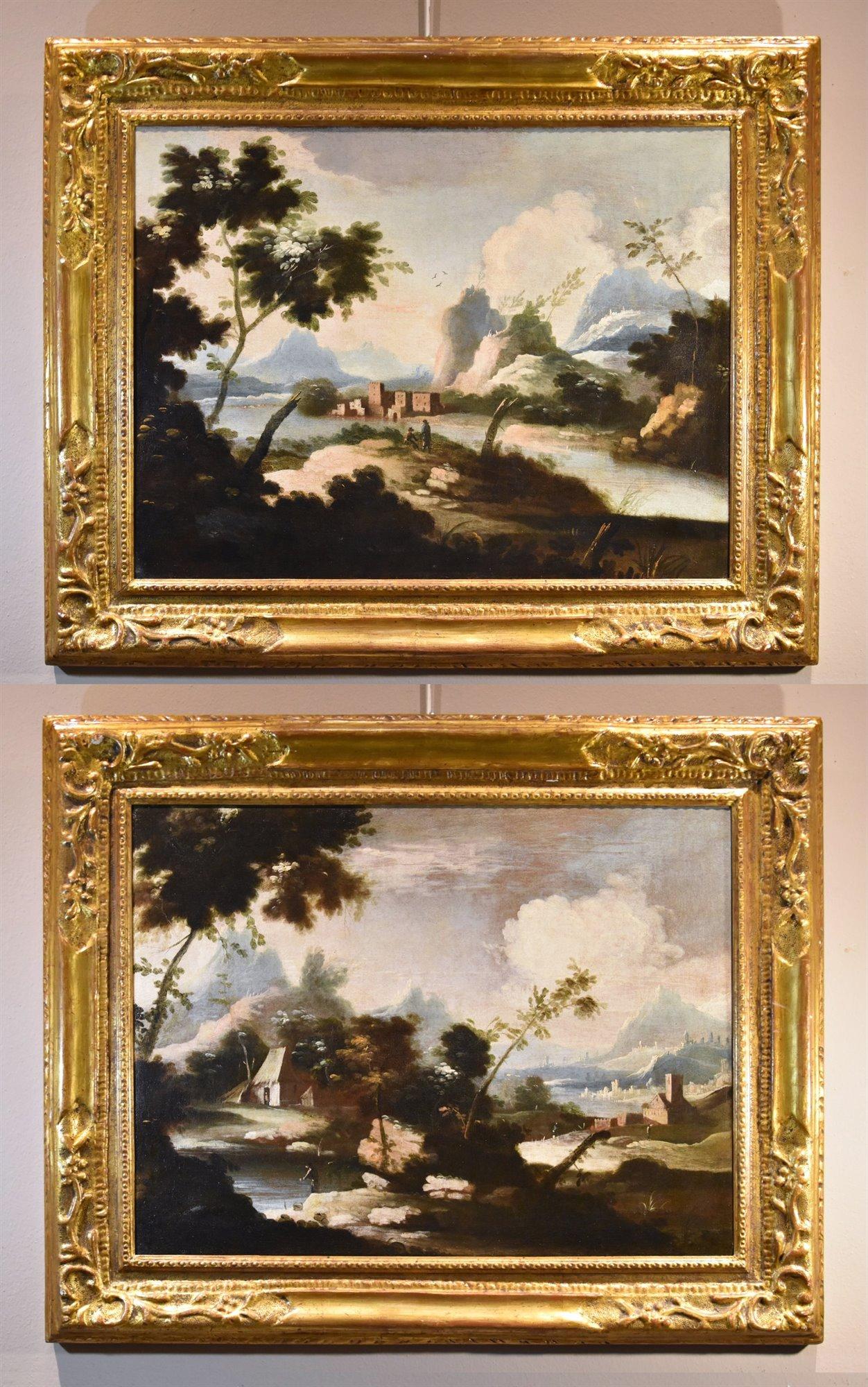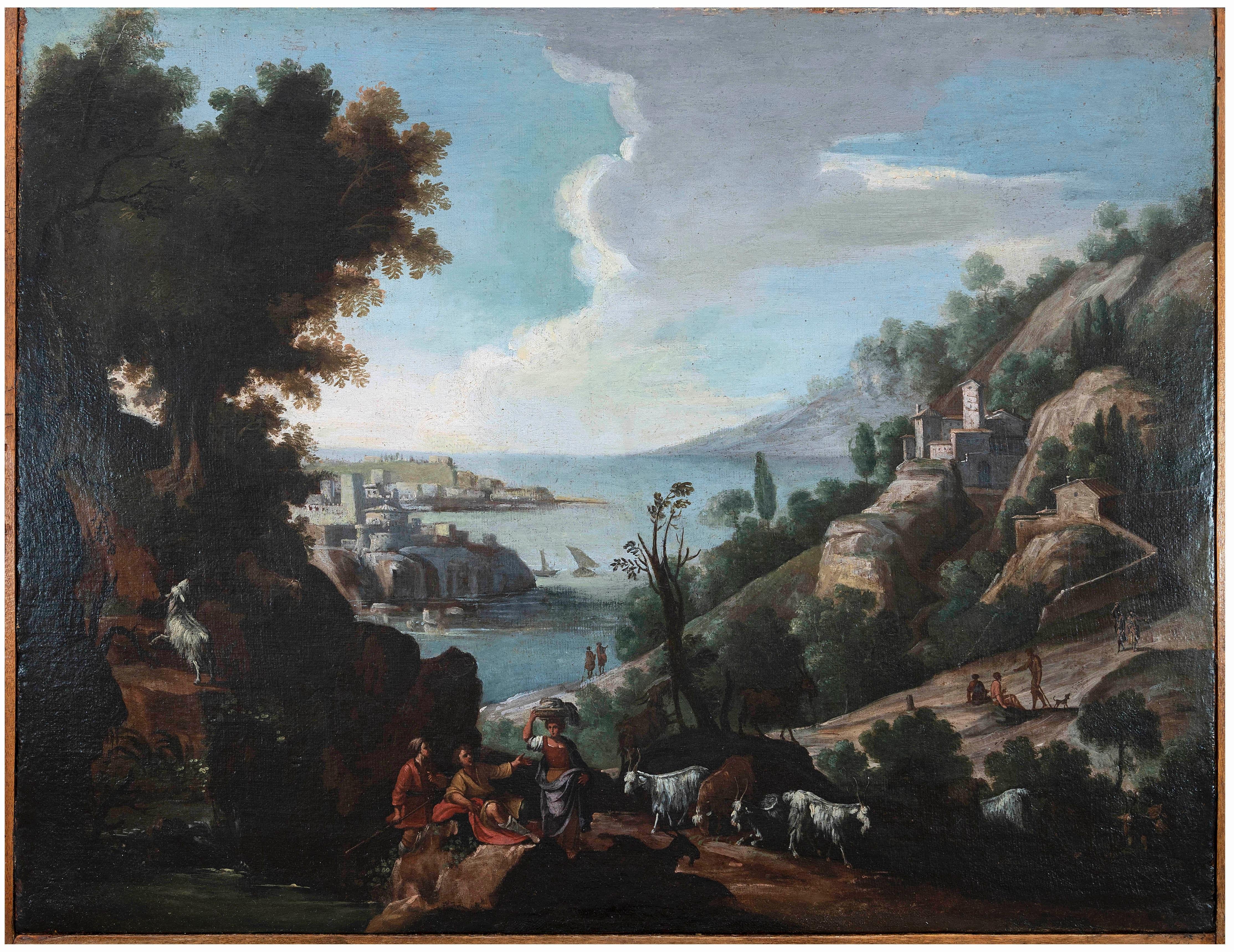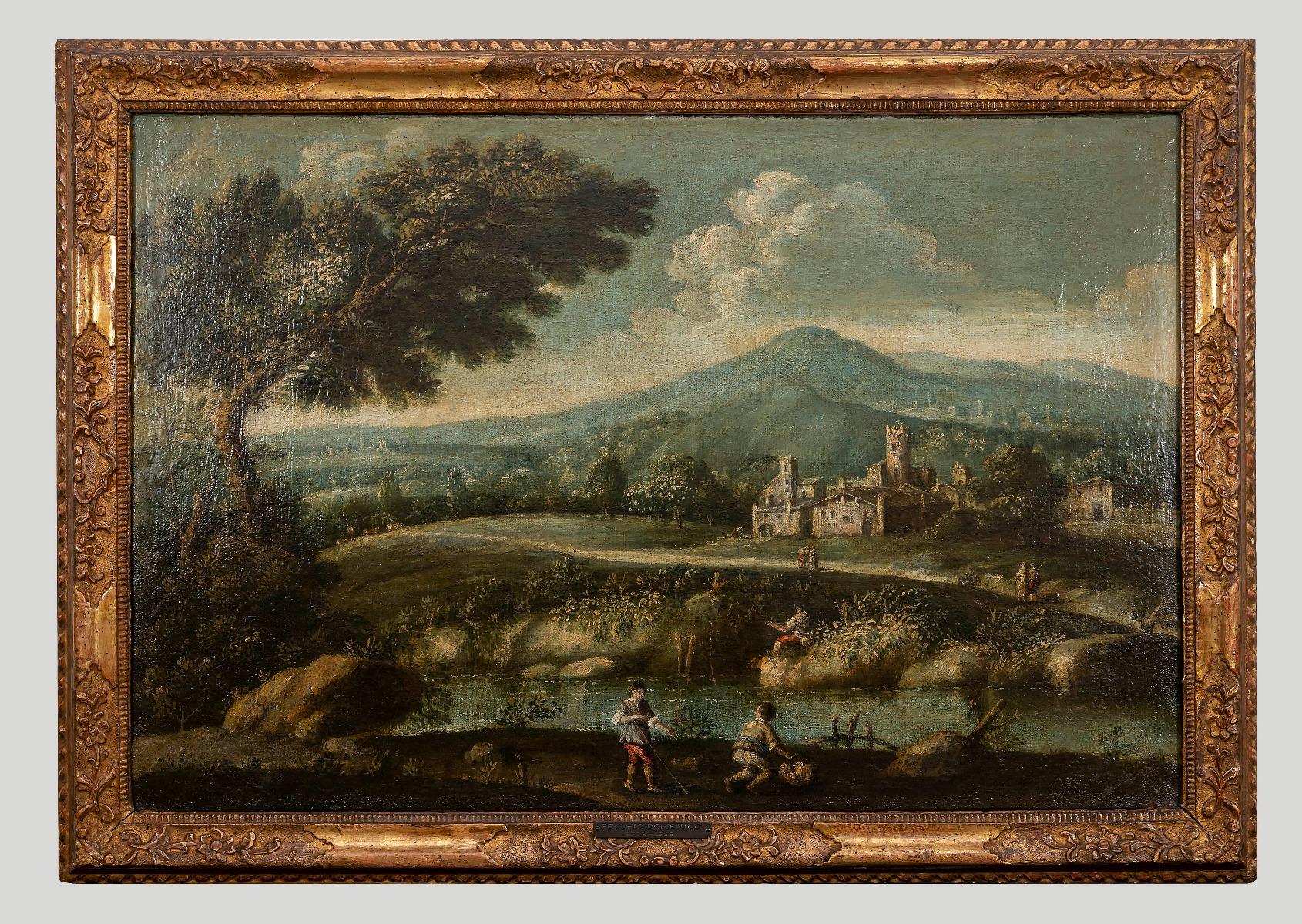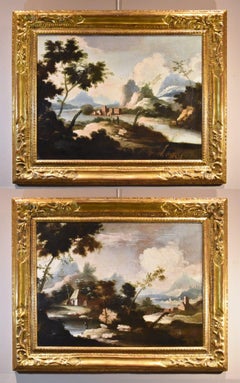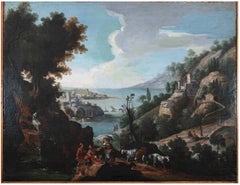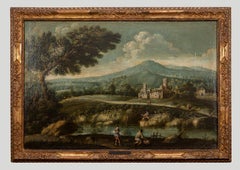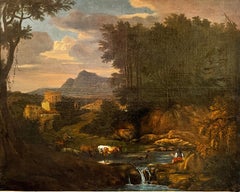Items Similar to Zais Landscape Couple Paint Oil on canvas Old master 18th Century Italy Venice
Want more images or videos?
Request additional images or videos from the seller
1 of 18
Zais Landscape Couple Paint Oil on canvas Old master 18th Century Italy Venice1725-1770
1725-1770
$15,336.24
$28,036.5645% Off
£11,416.83
£20,871.4045% Off
€12,800
€23,40045% Off
CA$21,006.81
CA$38,403.0845% Off
A$23,364.16
A$42,712.6145% Off
CHF 12,200.04
CHF 22,303.2045% Off
MX$284,316.98
MX$519,766.9845% Off
NOK 155,813.11
NOK 284,845.8445% Off
SEK 146,125.21
SEK 267,135.1545% Off
DKK 97,441.93
DKK 178,136.0345% Off
Shipping
Retrieving quote...The 1stDibs Promise:
Authenticity Guarantee,
Money-Back Guarantee,
24-Hour Cancellation
About the Item
Giuseppe Zais (Canale d'Agordo, Belluno 1709 - Treviso 1781)
Pendant of paintings - The assault of the brigands / After the assault
Oil on canvas, 108 x 42 cm. each
In the frame 128 x 62 cm.
We would like to thank Doctor Federica Spadotto for having studied this pendant of paintings and for bringing them back to the catalog of Giuseppe Zais. Below is an excerpt from the in-depth critical study.
The Venetian landscape of the golden century has now accustomed the public and scholars to extraordinary - as well as unexpected - contaminations between genres, sealing an artistic stage that is very permeable to international influences. This happens, without a doubt, by virtue of the "forest" origin linked to the rural repertoire, which records the fundamental contribution of the references from beyond the Alps (Spadotto, 2014) with regard to the inspiration and the expressive alphabet of indigenous artists.
Among the latter, the experience of Giuseppe Zais (Belluno 1709 - Treviso 1781), a painter who emigrated to the city of the lion probably between the thirties and forties of the seventeenth century, is fundamental, where he would have conducted his apprenticeship with the battalist Francesco Simonini (Parma, 1686 - Venice or Florence, post 1755). It was, in fact, a common practice for any painter who aspired to an official role - that is, enrollment in the Fraglia - to practice alongside an established character, such as the Parma master. More than a real apprenticeship, it is necessary to imagine the young painter active as an apprentice grappling with the warlike themes that had made Simonini famous in the Lagoon, where orders flooded with the consequent need to entrust part of the work to a valid help (i.e. to our Joseph).
Only recently, or thanks to the pictorial essays made known by Egidio Martini, has a nucleus of paintings made by Giuseppe been identified (fig. 1) on strict adherence to his master's repertoire and which for a long time had been believed to be Simoninian autographs.
The analysis of these specimens highlights close affinities of form and style with respect to the counterparts of Francis, on which the Zais inserts some guiding characters that will become typical of his manner, among which the round tower and the characteristic physiognomy of the faces stands out. .
Over the years, our artist will archive this experience in favor of the sunny afternoons of Zuccarellian inspiration, as well as collaborating with his son Gaetano (documented between 1765 and 1798) in his chosen genre. And precisely a landscape created by the latter and made known by the writer offers an important documentary piece to shed light on the extreme creative season of Ours, passed over in silence from the sources and devoid of autograph works.
In the Landscape conceived with figures, statues and animals at watering (fig. 2) the Zais junior hands down a compendium of his father's production, expressed through a rather dense ductus and a chromatic range played on "earthy" tones, in harmony with the revival of Marco Ricci (Belluno, 1676-Venice, 1730) very popular in the second half of the 18th century. Moreover, Zuccarelli himself (Pitigliano, 1702-Florence, 1788) had yielded to the seduction of Belluno, creating the Hunt for the bull (fig. 3) now at the Gallerie dell 'Accademia in Venice, a true exemplum with respect to the theme, where the same pictorial ingredients mentioned above emerge.
The remarkable pendant object of examination fits into this horizon, which "scans" like a real testament the long artistic career of Joseph, from his beginnings as a specialist in battles to the extreme synthesis of the late eighteenth century.
Simonini's soldiers become knights at the mercy of an attack by brigands, who kill them and strip them of all possessions, as happens in After the assault, in which the compositional system of the post-battle camp hosts the outcome of the fatal crime, perpetrated by characters in whom we recognize the clothes and the phosonomy of the villagers immortalized by Giuseppe in the famous rural passages.
The taste for detail, of clear Zuccarellian ancestry, blends with a fast, immediate style, which does not betray, however, the definition of the foliage in the typical, large trees called to frame the scenes, where the inspiration of the aforementioned Ricci blends with the Northern European "fashion" which was prevalent in the Venetian figurative culture in the late eighteenth century.
In spite of what the public's taste expressed for most of the golden century, electing the languid Arcadian poetry as the territory of its aesthetic ideals, the decline of the Serenissima brings back the echoes of that "stepmother nature" frequented by the first generation of landscape artists, which returns, very current, as a metaphor for a world destined to become extinct about ten years after his death.
- Attributed to:Giuseppe Zais (Canale d'Agordo, Belluno 1709 - Treviso 1781) (1709 - 1781, Italian)
- Creation Year:1725-1770
- Dimensions:Height: 50.4 in (128 cm)Width: 24.41 in (62 cm)
- Medium:
- Movement & Style:
- Period:
- Condition:
- Gallery Location:Riva del Garda, IT
- Reference Number:1stDibs: LU98818311682
About the Seller
4.9
Platinum Seller
Premium sellers with a 4.7+ rating and 24-hour response times
Established in 2017
1stDibs seller since 2018
255 sales on 1stDibs
Typical response time: <1 hour
- ShippingRetrieving quote...Shipping from: Riva del Garda, Italy
- Return Policy
Authenticity Guarantee
In the unlikely event there’s an issue with an item’s authenticity, contact us within 1 year for a full refund. DetailsMoney-Back Guarantee
If your item is not as described, is damaged in transit, or does not arrive, contact us within 7 days for a full refund. Details24-Hour Cancellation
You have a 24-hour grace period in which to reconsider your purchase, with no questions asked.Vetted Professional Sellers
Our world-class sellers must adhere to strict standards for service and quality, maintaining the integrity of our listings.Price-Match Guarantee
If you find that a seller listed the same item for a lower price elsewhere, we’ll match it.Trusted Global Delivery
Our best-in-class carrier network provides specialized shipping options worldwide, including custom delivery.More From This Seller
View AllLandscapes Couple Ricci Paint 18th Century Oil on canvas Old master Italy
Located in Riva del Garda, IT
Marco Ricci (Belluno 1676 – Venice 1730)
Circle of Pair of Arcadian landscapes with figures
Oil on canvas 56 x 72 cm. - Framed 77 x 93 cm.
This pair of charming landscapes, ex...
Category
18th Century Old Masters Paintings
Materials
Oil
Dughet Woodland Landscape Old master Paint Oil on canvas 17th Century Italy Art
By Gaspard Dughet, called Gaspard Poussin (Rome 1615 - 1675)
Located in Riva del Garda, IT
Gaspard Dughet, called Gaspard Poussin (Rome 1615 - 1675) - attributable to
Wooded landscape of the Roman countryside with the Archangel Raphael and Tobiolo
oil painting on canvas
second half of the 17th century
(cm.) 75 x 98, with frame 91 x 115
On the back old label inscribed "Monte dei Paschi di Siena"
The painting has characters clearly linked to the Roman culture of the seventeenth century and, in particular, to the works of Gaspard Dughet, an author who was able to achieve surprising results in describing the Lazio countryside with a unique grace and sensitivity.
Brother-in-law of Nicolas Poussin, of whom he was a pupil, Dughet is to be considered among the most important landscape painters of the Roman Baroque, highly sought after and celebrated by the aristocracy, a reference model for the artists of the following generation, such as Crescenzo Onofri, Jan Frans van Bloemen and Andrea Locatelli...
Category
17th Century Old Masters Paintings
Materials
Oil
$8,660 Sale Price
20% Off
Landscape Reder 17/18th Century Pait OIl on canvas Old master
Located in Riva del Garda, IT
Christian Reder (Leipzig 1656 - Rome 1729)
Landscape with pastoral idyll
Oil on canvas 66 x 132 cm Framed 76 x 143 cm
We present this delightful work, of which the matchin...
Category
17th Century Old Masters Paintings
Materials
Oil
$6,111 Sale Price
20% Off
Landscape Zuccarelli Paint Oil on canvas Old master 18th Century Italian View
By Francesco Zuccarelli (Pitigliano 1702 - Florence 1788)
Located in Riva del Garda, IT
Francesco Zuccarelli (Pitigliano 1702 - Florence 1788), circle of
Landscape with river and resting shepherds
First half of the 18th century
oil painting on canvas
cm. 60 x 93, within a carved and gilded wooden frame cm. 75 x 108
This delightful landscape view animated by a family of shepherds who rest from their daily duties should be compared to the hand of Francesco Zuccarelli (Pitigliano 1702 - Florence 1788);
In the landscapes painted by Zuccarelli the world is crystallized, frozen in a moment of idyllic quiet,
where the 'Arcadian' sense of the landscape is rendered with that pictorial vivacity, chromatic lightness and compositional grace that we find in its entirety in his painting.
By way of comparison we can compare our canvas to other compositions, including:
- Landscape with river and resting shepherds, Accademia Carrara, Bergamo
- Landscape with bridge and horseman, Accademia Carrara, Bergamo
- Landscape with river, village, fisherman and shepherdesses' (Christie's, London May 1960,
- Landscape with figures, Accademia Carrara,
- Landscape with knight and figures, Accademia Carrara
Tuscan by origin, Francesco Zuccarelli trained first in Florence with the landscape architect Paolo Anesi...
Category
18th Century Old Masters Paintings
Materials
Oil
$6,500 Sale Price
40% Off
Couple Landscape Man Woman Boucher Paint 18th Century Oil on canvas Old master
Located in Riva del Garda, IT
Francois Boucher (Paris, 1703 - 1770) - workshop/circle -
Pair of paintings The Surprised Lovers (Les amants surpris)/The Pleasant Lesson ('LAgréable Leçon)
18th century Oil o...
Category
18th Century Old Masters Paintings
Materials
Oil
$10,974 Sale Price
20% Off
Landscape See Paint Oil on canvas Flemish Old master 18th Century Italian Art
Located in Riva del Garda, IT
Flemish painter active in Italy in the eighteenth century
Coastal landscape of the Mediterranean with architectures and figures
Oil painting on canvas (69 x 88 cm., in frame 80 x 100 cm.)
The suggestive view proposed depicts a coastal view with a bay and the ruins of an ancient building, probably a monastery or a church, and in the background another building with a garden surrounded by high walls close to the shore.
The type of landscape, typical of the southern Italian environment, and the intimate atmosphere that welcomes the scene, attributes the authorship of the work to a landscape painter active in the eighteenth century, presumably in Italy in this period, with immediate references to the Dutch school , and in particular to the production of Jacob de Heusch and above all of Gaspar van Wittel, considered the progenitor of Italian landscape painting.
In fact, in the rendering of the architectural details, in the purity with which the buildings have been reconstructed, as well as in the atmosphere that encompasses the entire landscape, a marked correspondence to the so-called "Vanvitellian realism" can be seen: in fact, a comparison with a certain series of views which the Dutchman...
Category
18th Century Old Masters Paintings
Materials
Oil
$7,102 Sale Price
20% Off
You May Also Like
Landscape with Figures and Herd - Original Oil On Canvas - 18th Century
Located in Roma, IT
Landscape with figures and herd is an original oil on canvas realized in the 18th Century by a School Master of Central Italian School.
Original oil painting on Canvas.
The painti...
Category
18th Century Modern Landscape Paintings
Materials
Canvas, Oil
Landscape with figures - Original Oil Paint On Canvas - 18th Century
Located in Roma, IT
Landscape with figures is an original oil on canvas realized in the XVIII Century by a Venetian School Master.
Original oil painting on Canvas.
The painting represents a beautiful...
Category
18th Century Modern Landscape Paintings
Materials
Canvas, Oil
Classical Landscape - French 17th century art Old Master oil painting
By Jean François Millet
Located in London, GB
This superb 17th century French Old Master oil painting is attributed to Jean Francois Millet. Painted circa 1670 it is a classical landscape with figures by a bend in a river in the...
Category
17th Century Old Masters Landscape Paintings
Materials
Oil
$19,730 Sale Price
20% Off
Huge 18th Century Italian Old Master Oil Painting Figures & Animals Arcadian
Located in Cirencester, Gloucestershire
The Arcadian Landscape
Italian School, 18th century
oil painting on canvas, unframed
canvas size: 32 x 40 inches
condition: excellent condition for its age, fully restored.
provenance: from a private collection in Paris, France.
Large scale classical 18th century Italian Old Master...
Category
Early 18th Century Old Masters Landscape Paintings
Materials
Canvas, Oil
Landscape with figures, workshop of Paul Bril, Italian school 17th Century
By Paul Bril
Located in PARIS, FR
Idyllic landscape with myhological story of Cephalus and Procris
Early 17th century Italian school
Workshop Of Paul Bril (Antwerp, 1554 - Roma, 1626)
Oil on poplar panel: H. 28 cm (1...
Category
Early 17th Century Old Masters Landscape Paintings
Materials
Poplar, Oil
Pair of Italian 18' century Paintings with Gardens
Located in Rome, IT
Pair of Italian 18' century paintings , oil on canvas with Venetian Palace gardens , antiques sculptures and various figures .
Measurements with f...
Category
Mid-18th Century Old Masters Landscape Paintings
Materials
Oil
More Ways To Browse
Same Old
Italian Old World
Antique Old World Art
Old Masters Venice
Hand Painted Soldiers
Old Testament Paintings
Old Masters Paintings Of Venice
Antique Compendium
Antique Shed
Martini Light
18th Century Venetian Paintings
D Scan
Antique Autographs
Real Lion
Bull Paintings Antique
Couple Statue
Father Son Statue
Bull Pendant
